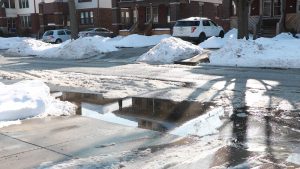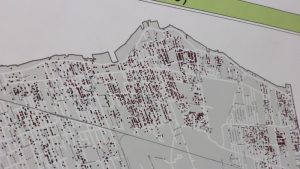Windsor preparing for possible surface flooding

An example of surface flooding on Partington Avenue in Windsor, Ont. on Feb. 15, 2018.
By Bernard DeVaal
The rising temperatures and forecast rain could test the city’s storm sewers yet again.
On many residential roads, catch basins are blocked by mounds of snow left behind by plowing, especially around parked cars.
“Sometimes people wouldn’t, couldn’t move their cars,” said City of Windsor engineer Mark Winterton. “When the plows came down, they pushed that large amount of snow and it didn’t push it right off the road but just onto the top of a catch basin.”
He added said people were notified to remove their vehicles off the roads during snow plowing and were even provided free parking at municipal lots.
This piled up snow leads to surface ponding especially in low lying areas. Rapid melting places strain on the city’s storm sewerage system.
This isn’t the city’s first rodeo — it has tracked 311 calls on the incidence of flooding spanning 18 years.

The map in Winterton’s office indicates high instances of surface and basement flooding in the Riverside area over a period of 18 years. Windsor, Ont. Feb. 15, 2018
And a map in Winterton’s office shows every call of significant surface or basement flooding.
“What this does is it helps us to game-plan. If we see a pattern that has developed we will then use that towards our capital plan and when we’re designing major infrastructure upgrades,” said Winterton.
Riverside Drive, for example, shows a pattern of high concentrations of overland issues. Areas like that are included in an eight-point plan that includes the master plan for upgrading the sewers.
“We’re already actively planning on doing some upgrades to the infrastructure as result of the August 29 event,” said Winterton, referring to last summer’s massive rainfall that resulted in thousands of flooded basements.
Winterton advises property owners to make sure that down spouts are cleared and directed away from the home and towards catch basins.
He is also asking for the community’s help.
“If there is a catch basin in front of your house and you’re able, dig it out. That will allow the water in your neighbourhood to get away and help in the public safety.”
Another major concern of surface ponding is hydroplaning where drivers lose control.
“Make sure when you’re driving, you can see the road. When the water is to a depth where you can’t see the pavement, we don’t recommend you drive through it,” Winterton cautioned.
Winterton said the city’s sewer system and pumps have ample capacity for regular conditions but are put to the test in extreme weather.
“We’re hoping that we don’t get a significant rainfall and that it’s strictly a melt event,” says Winterton. “Our sewers should be able to handle that adequately, depending on how much rain comes. We are well prepared both from a pollution control and sewer point of view.”


